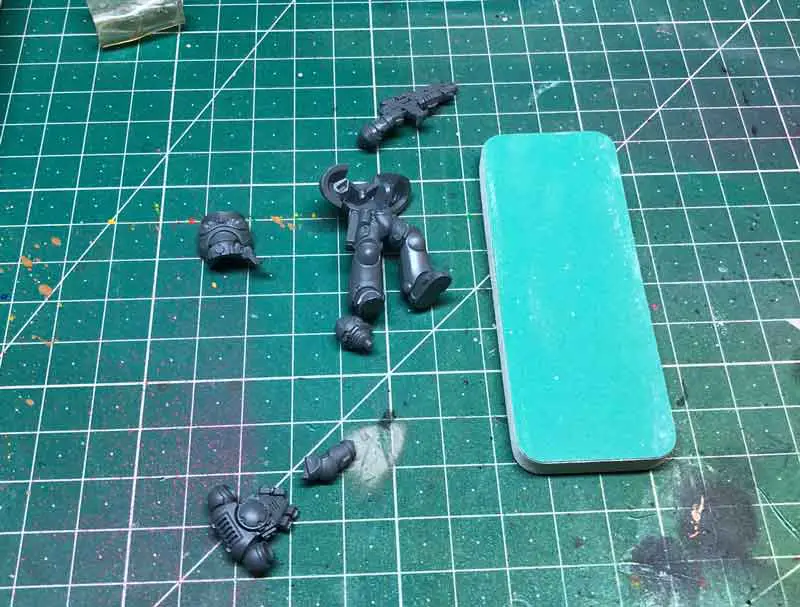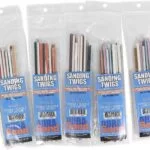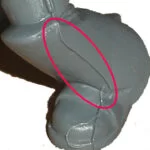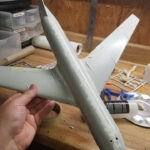Sanding miniatures (how to sand miniatures and is it a must)

Have you ever wondered if you can sand down parts of your minis to get a smooth finish where there is a join or where the part was connected to a sprue?
Most experienced builders often use a hobby knife for this task. But, the con of this step is that it can take too much off your minis, especially if you apply much pressure.
The sample question is, how do you get your mini’s surface and edges to look as smooth as possible without scratch marks?
Should you sand or file your miniature?
sanding a miniature can be beneficial for the end result. Sanding can help smooth out rough edges and imperfections, which can make painting and finishing the miniature easier and produce better results.
Sanding can also help to remove mold lines and other unwanted features that can detract from the final appearance of the miniature.
If you’re building a Warhammer 40k mini and have used 150-grit sandpaper, you’ll notice that this low grit gives your minis some noticeable “striping” or “rough marks” when sanding down the mold lines. But that doesn’t mean you can’t sand your minis.
Some mini painters 3D print their miniatures, and to achieve this, they’ll need their minis surface to be flawlessly smooth.
Sanding your minis smoothens the surface of your miniatures so that when you prime and paint your mini, the results you get are exceptional.
You just need to know which grit to use. Fine sandpapers with high grit numbers will work better on minis, unlike ones with small numbers.
On the other hand, Filing also works well for minis, especially Dungeons and Dragon Minis. They’ll help you get rid of mold lines and scratches.
How to sand a miniature
Here is a quick and useful guide I created about how to sand you miniatures the right way. Make sure to follow the steps for best results.
What you need
- Fine grit wet sandpaper or sanding sponge (120 and 320 grits)
- Scalpel
- anti-cut hand gloves
- Dishwashing soap
- Soft towel or rage
- Bowl
Steps to sand miniatures
- Fill a bowl with water and a small amount of dish soap.
- Cut the sheets of sandpaper into halves.
- Soak one cut-out part of sandpaper in water for some minutes.
- If you have a sanding squeeze or pad, wrap the sandpaper under it
- With the soaked sandpaper, Sand the key area gently in circular motions and with a light amount of pressure. Be sure to move the paper in multiple directions to promote even sanding.
- Add water when necessary as you sand your minis surface.
- Use the other grits to sand mini until smooth.
- Rinse the sanded area with water and allow it to dry with a soft towel or rag.
Should you sand any type of miniature?
Yes, you can sand any type of miniature, no matter what manufacturers make them from. They won’t damage so long you use the right sanding and watering technique.
If your mini has a metal form, you have to choose metal-based sandpaper. You’ll find different types of sandpaper, from aluminum oxide to garnet, silicon carbide, and ceramic. However, choose aluminum oxide or silicon carbide sandpapers. They work best on metals. Also, make sure to reapply water often on metal minis because they dry fast. You don’t want to run out of lubricant. This will make you leave more scratches on your miniature.
For wood, use a little amount of water before using sandpaper. They aren’t water-resistant and can cause severe damage. Instead of dipping wood minis in water, get a spray can or mist bottle to minimize the liquid.
What will be the best sandpaper for miniatures
Sometimes, it can be hard to get a file or sandpaper everywhere you’d want them in your mini, especially if they are low grit.
Therefore, the best sandpaper to smoothen your minis should:
- It should have nice high grit numbers, between 400 to 900-grit.
- Make sure it has appropriate coarseness (finer sandpaper)
- Choose the right sandpaper materials, preferably one made of silicon carbon. They are durable and work well on plastic, metal, and wood.
- Get sandpaper that doesn’t tear easily when sanding.
Conclusion
How you sand determines the results you get on your mini.
Sanding your miniatures with high pressure can leave swirl marks and scratches on the paint and clear coat, while the right motions and pressure offer exceptional textured surface.
Just make sure to take the time to study the material used in building minis and watch videos on how to sand minis o YouTube, and in time, you’ll progress to an experienced painter.





